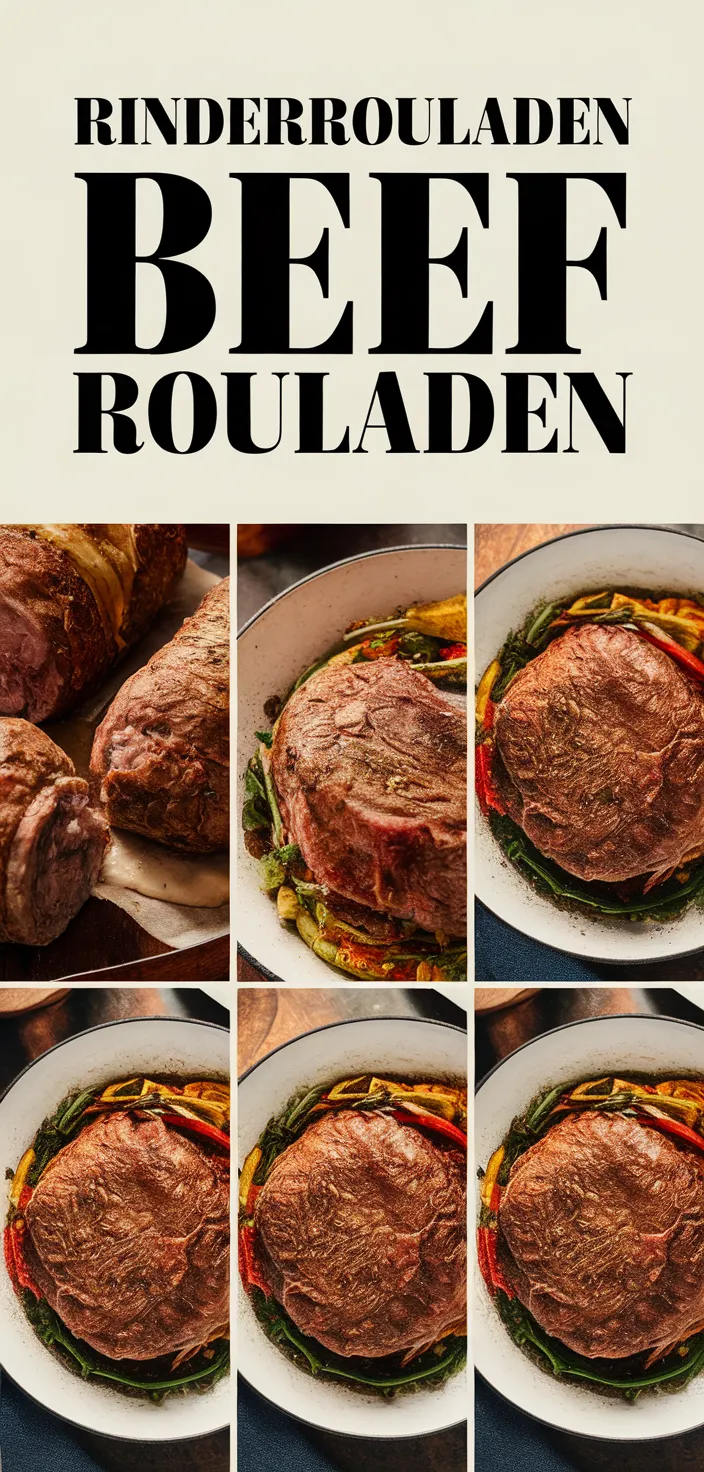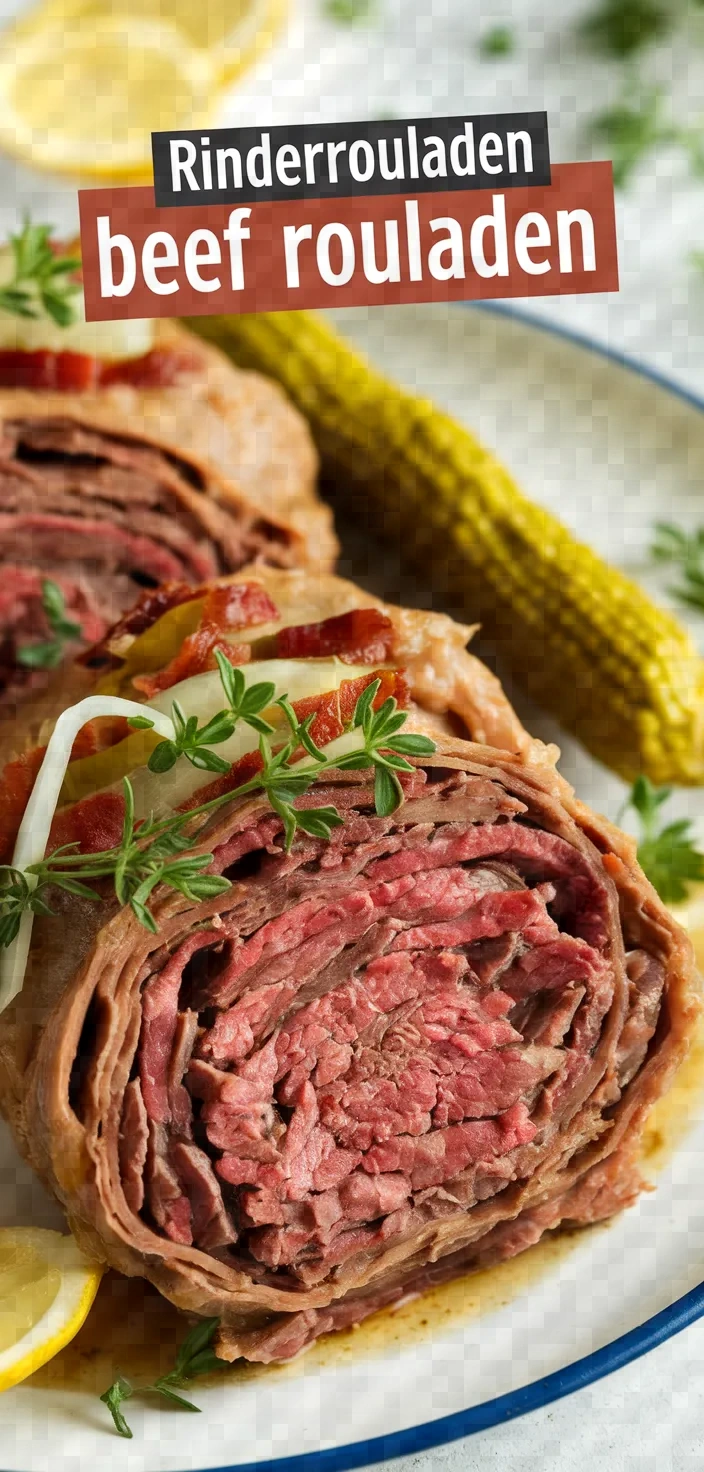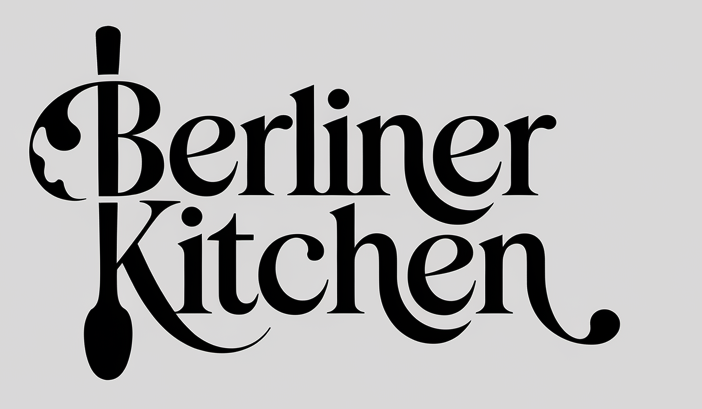I absolutely adore this beef roulade recipe because it takes me on a flavor-packed journey straight to cozy European kitchens, blending rich beef, tangy mustard, and savory bacon in a hearty hug. Plus, the low-and-slow simmering in red wine and beef broth makes the house smell incredible and always impresses my friends at dinner parties.

I’m thrilled to present my interpretation of the classic German dish Rinderrouladen. It takes the elements of supper and serves them up in neat little packages—tender, flavorful bits of beef loaded with zippy ingredients like German mustard and smoky bacon, along with something that’s near and dear to my heart: pickles.
I hardly ever eat an actual pickle these days, but the classic dill—I’m partial to “half sour”—remains one of my favorite ingredients. Zippy.
Crunchy. Dill-y.
Eating a Rinderroulade is just like eating supper, but elevated, which makes it perfect for any occasion.
Ingredients

Beef Roulades:
High in protein, necessary for the growth and repair of muscles.
Mustard:
Imparts sharp taste, reduced in calories, includes antioxidants.
Bacon:
Imparts a smoky taste, loaded with fat and sodium.
Onion:
Yields natural sweetness, possesses dietary fiber and vitamins.
Pickles:
Impart tanginess, few calories, plentiful probiotic content.
Beef Broth:
Intensifies umami taste, has collagen and minerals.
Red Wine:
Provides depth, is rich in antioxidants and polyphenols.
Parsley:
Garnish that is rich in vitamins A, C, and K and that is fresh.
Ingredient Quantities
“`html
- 4 large beef roulades (approximately 4×6 inches each)
- 2 tablespoons mustard (preferably German mustard)
- 4 slices of bacon
- 1 large onion, finely chopped
- 8 small pickles, sliced (gherkins or cornichons)
- Salt and pepper to taste
- 2 tablespoons vegetable oil
- 1 cup beef broth
- 1/2 cup red wine
- 1 tablespoon all-purpose flour
- 2 tablespoons butter
- 1/4 teaspoon sugar (optional, to taste)
- 2 tablespoons parsley, chopped (for garnish)
“`
Instructions
1. Begin with the beef roulades laid out flat on a clean surface. Each should be seasoned with salt and pepper, and a thin layer of mustard should be spread over each piece of meat.
2. Put a slice of bacon on each beef roulade, which has been coated with mustard.
3. Distribute equally along the length of each roulade the finely chopped onion and sliced pickles.
4. Each beef slice is rolled up tightly, with the ends tucked in, to form a roulade. Kitchen twine or toothpicks hold the shape and keep the beef from falling apart during cooking.
5. In a large skillet, over medium-high heat, heat the vegetable oil. Brown the roulades on all sides until they are beautifully colored. This should take about 8-10 minutes.
6. Remove the roulades from the skillet and set them aside. In the same skillet, add the butter and allow it to melt.
7. Add the flour, then stir together with the melted butter in the skillet until well combined and forming a roux. Let the roux cook, bubbling gently, for about 1 minute, then slowly whisk in the red wine.
8. Pour the beef broth into the skillet and give it a stir. You’re going to want the sauce to be smooth before proceeding to the next step, so if you see any lumps, try to work them out. Once it’s all smooth and looks delicious (because it should), return the roulades to the skillet. And here’s the most crucial element: Make sure they are sitting in the sauce and not, like, half-submerged in the sauce.
9. Put a lid on the skillet and turn down the heat to low. Let the rouladen simmer gently for about
1.5 to 2 hours, or until the meat is fork-tender.
10. When the sauce is done cooking, add salt, pepper, and a pinch of sugar to taste. Roulades look really nice when garnished with freshly chopped parsley, which is what you’re going to do right before serving. Now, sit back and relish this dish!
Equipment Needed
1. Cutting board
2. Chef’s knife
3. Measuring spoons
4. Toothpicks or kitchen twine
5. Large skillet with lid
6. Whisk
7. Tongs or spatula
8. Mixing bowl (optional, for organizing ingredients)
9. Wooden spoon or heat-resistant spatula
FAQ
- What kind of beef should I use for Rinderrouladen?The ideal choice is to use thin slices of top round or flank steak. For rolling, the slices should measure approximately 4 by 6 inches.
- Can I use another type of mustard instead of German mustard?German mustard imparts a distinctive taste; however, it can be replaced in a pinch with Dijon mustard, if necessary.
- Is there a substitute for red wine in the recipe?Indeed, using extra beef broth or grape juice in place of red wine is an option.
- How should I secure the rouladen rolls during cooking?Kitchen twine or toothpicks can be used to secure the rolls and prevent them from unraveling.
- Can the sugar be omitted from the recipe?Indeed, the sugar serves as an optional component and can be completely juxtaposed if you so wish, or it can be added in accordance with your individual palate, since some people have a greater fondness for sweet flavors than others.
- How long should I cook the rouladen for optimal tenderness?Cook the rouladen at a low simmer for approximately 90 minutes or until the beef becomes tender and is infused with deep, satisfying flavors.
- What is the purpose of the flour in the recipe?The sauce is thickened with flour, resulting in a richness and a consistency like that of gravy.
Substitutions and Variations
If German mustard is unavailable, you can substitute it with either Dijon mustard or yellow mustard.
Bacon: Use pancetta or prosciutto instead to get a comparable smoky flavor.
Pickles: Swap with capers or olives that have been sliced for a different yet equally tasty tang.
Red Wine: Replace with extra beef broth or a dash of balsamic vinegar for a non-alcoholic option.
Flat-leaf parsley can be replaced with cilantro or chives. Both impart a similar herbal note, albeit with a distinctive tasting twist.
Pro Tips
1. Tenderize the Meat: Before spreading the mustard, gently pound the beef roulades with a meat mallet. This step helps to achieve a more tender texture in the final dish.
2. Even Filling Distribution: Ensure the bacon, onion, and pickles are distributed evenly on the beef. This ensures a consistent flavor throughout each bite and avoids bulging in certain areas when rolling.
3. Browning the Roulades: Take your time to brown the roulades well on all sides. A deep, even browning contributes a rich flavor to the dish and enhances the color of the final sauce.
4. Deglaze and Scrape: When adding the red wine to the skillet after browning, scrape the bottom to release the flavorful browned bits stuck to the pan. This adds depth to the sauce.
5. Avoid Over-Thickening: When making the roux and adding liquids to it, if the sauce seems too thick, add a little more beef broth or water to reach the desired consistency. The sauce will reduce and thicken further as it simmers with the roulades.

Rinderrouladen Beef Rouladen Recipe
My favorite Rinderrouladen Beef Rouladen Recipe
Equipment Needed:
1. Cutting board
2. Chef’s knife
3. Measuring spoons
4. Toothpicks or kitchen twine
5. Large skillet with lid
6. Whisk
7. Tongs or spatula
8. Mixing bowl (optional, for organizing ingredients)
9. Wooden spoon or heat-resistant spatula
Ingredients:
“`html
- 4 large beef roulades (approximately 4×6 inches each)
- 2 tablespoons mustard (preferably German mustard)
- 4 slices of bacon
- 1 large onion, finely chopped
- 8 small pickles, sliced (gherkins or cornichons)
- Salt and pepper to taste
- 2 tablespoons vegetable oil
- 1 cup beef broth
- 1/2 cup red wine
- 1 tablespoon all-purpose flour
- 2 tablespoons butter
- 1/4 teaspoon sugar (optional, to taste)
- 2 tablespoons parsley, chopped (for garnish)
“`
Instructions:
1. Begin with the beef roulades laid out flat on a clean surface. Each should be seasoned with salt and pepper, and a thin layer of mustard should be spread over each piece of meat.
2. Put a slice of bacon on each beef roulade, which has been coated with mustard.
3. Distribute equally along the length of each roulade the finely chopped onion and sliced pickles.
4. Each beef slice is rolled up tightly, with the ends tucked in, to form a roulade. Kitchen twine or toothpicks hold the shape and keep the beef from falling apart during cooking.
5. In a large skillet, over medium-high heat, heat the vegetable oil. Brown the roulades on all sides until they are beautifully colored. This should take about 8-10 minutes.
6. Remove the roulades from the skillet and set them aside. In the same skillet, add the butter and allow it to melt.
7. Add the flour, then stir together with the melted butter in the skillet until well combined and forming a roux. Let the roux cook, bubbling gently, for about 1 minute, then slowly whisk in the red wine.
8. Pour the beef broth into the skillet and give it a stir. You’re going to want the sauce to be smooth before proceeding to the next step, so if you see any lumps, try to work them out. Once it’s all smooth and looks delicious (because it should), return the roulades to the skillet. And here’s the most crucial element: Make sure they are sitting in the sauce and not, like, half-submerged in the sauce.
9. Put a lid on the skillet and turn down the heat to low. Let the rouladen simmer gently for about
1.5 to 2 hours, or until the meat is fork-tender.
10. When the sauce is done cooking, add salt, pepper, and a pinch of sugar to taste. Roulades look really nice when garnished with freshly chopped parsley, which is what you’re going to do right before serving. Now, sit back and relish this dish!
